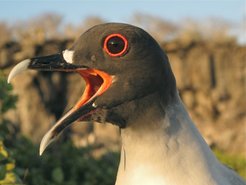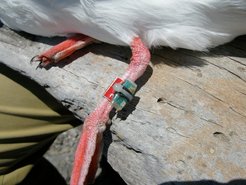Lunar cycle determines hunting behaviour of nocturnal gulls
Zooplankton, small fish and squid spend hardly any time at the surface when there's a full moon. To protect themselves from their natural enemies, they hide deeper down in the water on bright nights, coming up to the surface under cover of darkness when there's a new moon instead. Scientists at the Max Planck Institute for Ornithology in Radolfzell discovered that this also influences the behaviour of swallow-tailed gulls (Creagrus furcatus), a unique nocturnal species of gull from the Galapagos Islands. They fitted the birds with loggers and wet/dry sensors which enabled them to see how much time the animals spent at sea at night. Their findings show that the birds' activity was greatest at new moon, in other words the time when the most prey was gathered at the surface of the water. The cycle of the moon therefore also influences the behaviour of seabirds.

The lunar cycle controls the behaviour of various animal species: owls, swallows and bats, for example, align their activity with the phase of the moon to maximise their hunting success. However, marine life is also affected by the moon. Many species of fish hide from their enemies in the depths of the sea during the daytime and only come up to the water's surface in the dark. Known as vertical migration, this phenomenon is additionally influenced by the lunar cycle. The fish thereby avoid swimming on the water's surface at full moon where they would be easy prey. Vertical migration is thus restricted on brighter nights and the animals remain at greater depths. At new moon, on the other hand, the organisms become active and migrate to the surface.
Yet also in the dark of night hunters lie in wait for them – for instance the swallow-tailed gull Creagrus furcatus from the Galapagos Islands. With eyes that are well adapted to the dark, the gull can see fish below the water's surface even in low light conditions and so does not need the moon as a source of light. Scientists from the Max Planck Institute for Ornithology therefore wanted to find out what effect the lunar cycle had on the hunting behaviour of the gulls.
To this effect, they attached loggers with sensors to 37 birds, which enabled the scientists to measure where, when and how long the animals were in the water. "The gulls fly off to hunt on the open sea and plunge down to the water's surface to snatch squid or small fish," explains Martin Wikelski from the Max Planck Institute in Radolfzell. "From the contact time of the sensors with the water, we were able to conclude in which nights of the month the gulls were particularly active." The behaviour of each bird was recorded for 120 days on average in order to take in several moon phases.

The birds followed the lunar cycles strictly: at new moon the gulls were in the water particularly often. When the nights were very bright, the birds tended to stay on dry land instead. "For the swallow-tailed gulls it makes sense to be guided by the lunar cycle in their hunting, because, with a diving depth of no more than one metre, the prey is quickly beyond their reach on nights with a full moon," says Wikelski.
To facilitate their nighttime hunting, swallow-tailed gulls have evolved light-sensitive eyes that are particularly well adapted to the dark nights at sea. They have also lost their melatonin rhythm – an important clock that regulates sleep – enabling the swallow-tailed gulls to occupy a new and unique ecological niche.
NB/HR

